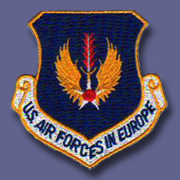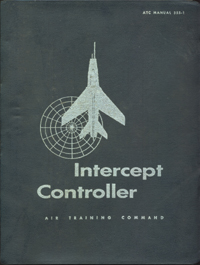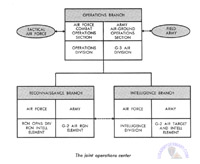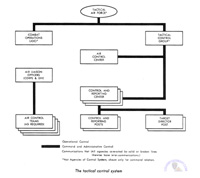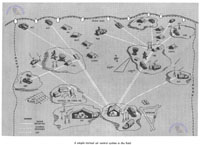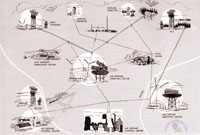Tactical Air Control System |
||||
|
||||
| Tactical Air Control System | ||||
| (Source: Intercept Controller, ATC Manual 355-1, July 1955) | ||||
| EARLY 1950s | ||||
| TACTICAL AIR OPERATIONS SYSTEM | ||||
Within a given area of responsibility, the general mission of Army ground forces and tactical air forces in a theater of operations is the same - to destroy the enemy's ability to wage an offensive, smash the enemy's defense, and follow the collapse of the enemy's defense with an offense. Both services help to accomplish this mission. Completion of the mission requires the coordinated effort of the Army and Air Force, and close coordination means close cooperation. This is achieved through combined Army-Air Force operations planning centered at the joint-operations center. As a controller or director assigned to a tactical air force, you will work within the tactical-air-operations system - the Air Force half of the joint operations. You should first be familiar with Air Force operations insofar as tactical coordination with the Army is concerned. The tactical-air-operations system provides a tactical-air-force commander with the organization and equipment required to plan, direct, and control air operations. It is through this system that the air force commander is able to achieve centralized control over his forces and integration of effort between the air force and the field army. The tactical-air-operations system consists of five components to be discussed in detail: The combat-operations section of the joint-operations center (JOC); the tactical-air-control system; the air liaison officers assigned to Army units; an Air Force communications group; and air combat units assigned to the tactical air force. The complete system is illustrated below. |
||||
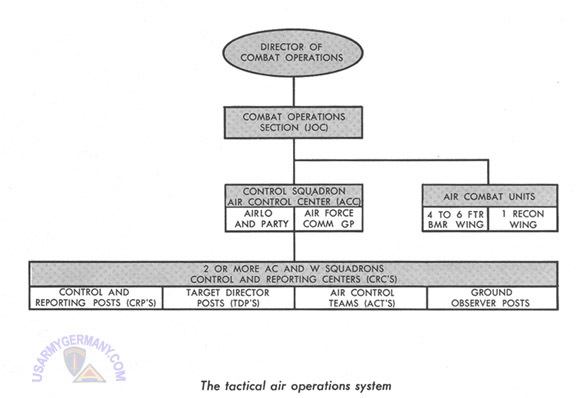 |
||||
COMBAT-OPERATIONS SECTION OF JOC |
||||
|
||||
|
||||
| Information regarding the current air situation is funneled into the ACC from radar and ground-observer plots, the radio intelligence service, and friendly-aircraft-movement orders. All of the information received at the center from all sources is displayed in graphic form for use in aircraft control and warning. The ACC collects information and relays it to the combat-operations section of the AOC. Commands are then issued from the combat operations section through the control center over its communications net to all units concerned. The control center should have some command authority delegated by the combat operations section in instances, for example, such as diverting an airborne formation on a low-priority mission, scrambling a ground alert, or intercepting an air attack. Additional functions of the ACC include: 1. Directing the operations of the tactical air-control system. 2. Initiating action against hostile aircraft. 3. Coordinating fighter aircraft and antiaircraft artillery. 4. Coordinating fighter interceptions when one control and reporting center relinquishes control and another takes over. 5. Disseminating air-raid warnings. 6. Supervising control of aircraft on missions. 7. Assigning control missions to control and reporting centers and air-control teams. 8. Providing navigational aid to friendly aircraft. 9. Maintaining liaison with control systems of other air forces. CONTROL-CENTER COMMUNICATIONS. The ACC is located in a forward area. Generally it is in the same building or tent as the AOC. If not, the two are connected by a communications network. To tie together the control center and AOC, immediate and dependable communications are needed. Usually, the only acceptable means is voice-telephone, VHF radio, or FM radio. Wire circuits offer greater security and may be used when mobility and terrain features permit. INFORMATION AND PLOTTING. Air-surveillance information coming into the control center is displayed on a large, horizontal plotting board. An accurately scaled map of the area of operations has been drawn on the plotting board. A grid is superimposed over the map to facilitate accurate positioning of airborne plots. Airfields, obstacles, and other air-situation information appears on the map as well as Army and corps boundaries and areas defended by AAA. A ground liaison officer maintains separate information about the ground situation on a map mounted on a wall board. As airborne movements are reported, display stands are placed on the plotting board to show the position of the tracks. Plaques inserted on the stands denote track number (for identification purposes), number of aircraft in formation, their altitude, and whether they are friend, foe, or unidentified. Operational-status boards are maintained for the purpose of indicating current status of weather, assigned radar and communications facilities, aircraft availability, operational status of AAA, mission data, etc. CONTROL-CENTER PERSONNEL. Control-center personnel are on 24-hours-a-day duty to provide a display of information by which air weapons, antiaircraft artillery, and air-raid warning functions within the area of responsibility may be supervised and coordinated. In charge of the control-center personnel is the senior tactical-air controller, assisted by deputy senior controllers. Several deputy controllers are required, the number depending on the amount of air traffic expected in the area and the number of friendly units to be controlled. These controllers may be given primary duty functions, such as air-surveillance officer or movementidentification officer. Other personnel in the center include an antiaircraft-artillery officer, a communications officer, a weather officer, and liaison officers. All these officers advise the controllers or coordinate air activity with their services. The AAA officer has direct wire or radio contact with the antiaircraft-artillery-operations center. Since, under Air Force policy, the unified commander gives the tactical-air controller hold-fire authority over AAA, the tactical controller and AAA officer coordinate their air-defense units in the ACC. The operational breakdown by section of control-center personnel is similar to that described for the ADCC in the chapter on air defense organization (chapter 1). Control and Reporting Center (CRC) Is Lower-Echelon Control and Warning Unit The control and reporting center, unlike the ACC, is a lower-echelon control unit which directs aircraft and does most of the actual reporting for the tactical-air-control system. The CRC is comparable to the ADDC in air defense. Long-range radar installed at the CRC is able to report accurately the azimuth, range, and height of airborne targets within a large area. All information collected by the CRC is sent immediately to the ACC and is one of the chief sources of the control center's intelligence. The area searched by CRC radar is presented on PPI scopes located in the control room of the CRC. Duty controllers operating the PPI scopes are in direct contact with the aircraft. They can control the aircraft on tactical missions and furnish them with early warning of approaching enemy aircraft and information about navigation. Information obtained from the scopes is plotted on a vertical, Plexiglas plotting board placed where it can be seen easily. Except for short periods, when equipment is being serviced or moved, CRC radars operate 24 hours a day. Unlike the control center, the control and reporting centers do not have duplicate equipment and must be temporarily out of action while being moved. When the control center moves, one CRC is delegated to assume the ACC responsibility and a team from the AOC and ACC are sent to the unit to perform the duties. In case the control center should go out of operation, each control and reporting center acts as its own control center. During such an emergency, communications between all control and reporting centers and the AOC must be maintained to allow coordination of air warning and control through the area. Should the AOC or their communications go out as well, each CRC should coordinate with all other CRCs to present an integrated effort. The control and reporting center is sited in a specifically defined area. Adjacent CRCs overlap to eliminate radar "blind" spots and to allow one CRC to take over if another is put out of action. An ideally situated control and reporting center covers 60 miles for low altitude targets, and 200 miles for high-altitude targets (based on radar capabilities). The operational breakdown by section of the CRC personnel is similar to that described for the ADDC in the chapter on air-defense organization. The officer in charge of the CRC is the tactical-air director. Either he, or a chief duty controller, is present at the control and reporting center at all times. As work is sent down to the control and reporting center from the ACC, the director divides it among the duty controllers, briefing each controller on his mission and giving him information on the type of aircraft to be used, armament, target, expected enemy action, air-to-ground communications data, and secondary control units to be used. The director or chief duty controller notifies the control center when the control and reporting center has taken over a mission, when the mission is over the target, and when the mission is completed. As soon as possible, the director gives the control center the results of the strike, including number of aircraft lost or damaged and amount and type of enemy fire encountered. When an air strike calls for the specialized control of either a target-director post or air-control team, the tactical-air director or chief duty controller directs the aircraft to these units in the target area and briefs them about the mission if they were not briefed prior to takeoff. Control and Reporting Posts (CRPs) Are Highly Mobile Radar-Warning Units Assigned under the control and reporting center are highly mobile, lightweight radar stations called control and reporting posts. The primary mission of the CRP is to furnish early-warning information to the control and reporting center to which it is operationally responsible. The CRP is sited well in advance of the CRC in order to extend and fill gaps in the coverage of the CRC radar. The CRP must be highly mobile in order to shift its position as the battlefront changes. Normally, the CRP only reports air-movement information and does not control friendly aircraft. Target-Director Posts (TDPs) Are Special Radar-Control Elements Each CRC has one or more target-director posts which are special control elements of the tactical-air-control system. A TDP performs no air-warning service, but is used to position friendly aircraft over predetermined target coordinates or geographical locations. The TDP is equipped with air-to-ground radio, adequate point-to-point communications, and specialized close-support radar (usually an MSQ-1 or MPQ-2) mounted in vans. This radar unit is a modification of the SCR-584 antiaircraft and gun-laying radar. It can be quickly moved close to the position where an air strike is to be made, and can be in operation within thirty minutes after arriving. This mobility is essential to the TDP since it must be resited frequently to take care of the missions assigned to it. The range of the radar is comparatively short, but can be extended with beacon. The radar is extremely accurate and possesses a narrow, conical beam. This beam of radar energy is locked on the aircraft being controlled, and the tracking is done automatically. Only one flight can be controlled at a time. The very characteristics that make the close-support radar an accurate control radar make it a poor search radar. When the narrow beam is locked on a flight, the control and reporting center must continue to monitor the flight to provide early warning of approaching enemy aircraft and navigational assistance. After a TDP is briefed for its close-in mission, it prepares to take over control. The control and reporting center vectors the flight to a predetermined point where it is picked up by the radar of the director post. The radar locks on the flight, and instructions are given to the flight leader as to altitude, direction, and speed from data prepared in advance. The TDP controller then follows the flight with the information presented on his plotting board, and vectors the flight on a predetermined bomb run to the precomputed bomb-release point. The bombs are released on the signal from the controller. The CRC assumes control of the flight when the mission is completed. Air-Control Teams (ACTS) Visually Direct Close-Support Missions The air-control team (usually three or more within an Army division) consists of a rated officer and one to three enlisted men equipped with VHF air-to-ground radio and point-to-point communications with the control and reporting center. The officer is called a forward air controller. Generally he rides in a jeep, halftrack, tank, or other vehicle to keep up with the division front. Sometimes he hovers over the front lines in a liaison aircraft, and is then known as the air coordinator. The air-control team has no radar and directs an air strike by being in a position where it can see both the aircraft and target. When the ACT is assigned to a close-support mission, it moves to the portion of the front to be supported and reports to the Army unit requesting support. The ACT ties in with the communications net of the Army and establishes close coordination with the S-3 officer. Once the party has a clear idea of the position of the troops, it can direct close air support. In combat, an aircraft is vectored to the target area from the control and reporting center (CRC). Then the forward controller takes over. He directs the attack and warns the aircraft against flak and other aircraft. As the aircraft approaches the target, the controller gives information on locating the target and may suggest the best approach or technique for attack. He always insists upon precautions for the safety of friendly troops. He directs artillery to mark the target or to counter enemy fire. The commander of the ground unit, if he wishes to cancel a mission, does so through the forward controller. The forward controller is a pilot from a local combat unit who understands the problems involved in flying a close-support mission. He anticipates the questions the pilot may ask and has the answers. In Korea, where the US had air superiority, forward observers were flown over the target area in AT-6 aircraft -- referred to as "mosquito" missions. Their purpose was to assist the ACT in target selection and position, or to act as the ACT. Ground Observers Report Aircraft Sighted Visually Ground observers also are located near the front lines, but unlike forward controllers, they do not direct aircraft. Ground observers are joined to the CRC by point-to-point communications. They report on aircraft in areas where radar coverage is poor or impossible. The better the radar coverage, the fewer the ground observers required. These are military personnel, unlike the observers in the us. AIR LIAISON OFFICER The third component of the tactical-airoperations system is the air liaison officer (ALO). Appointed and supervised by the director of combat operations at the JOC, the ALO represents the tactical-air-force commander at the various Army corps and division headquarters. He assists Army personnel in planning air support and keeps them informed of the overall priority of air operations. The ALO usually confines this assistance to advisory statements. Together with necessary communications, personnel, and air-toground and point-to-point communications, the ALO forms an air liaison party (ALP). The ALO or ALP operates, under most circumstances, in the fire-support-coordination center. AIR FORCE COMMUNICATIONS GROUP Yet another (fourth) component of the tactical-air operations system is the air-force communications group. This group installs, maintains, and operates all terminal communications for the tactical-air force, including switchboards, telephones and telegraph terminal equipment, radio terminals, and a communications center including cryptographic facilities. The group also provides necessary radio and wire facilities required to link the tactical-air commands and subordinate tactical air forces with lateral and subordinate units and installations. AIR COMBAT UNITS The final component of the tactical-air operations system is made up of air combat units assigned to the tactical air force. An air force will usually have from four to six fighter-bomber wings and necessary reconnaissance support. |
||||
| AC & W COMMUNICATIONS SYSTEM | ||||
| USAFE Manual 55-5 (March 1961) | ||||
| (Source: Employment of Air Defense Forces in the Central Euroepan Area, USAFE Manual 55-5, March 1961) | ||||
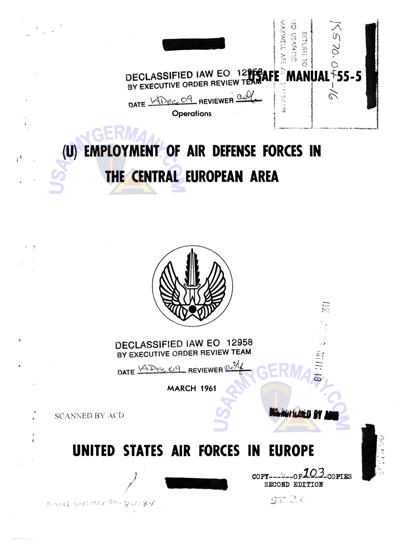  |
||||
| NATO Command & Control Doctrine | ||||
